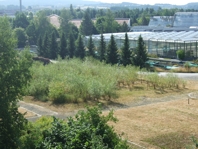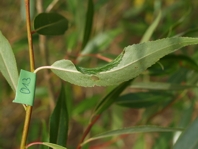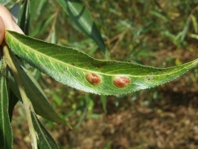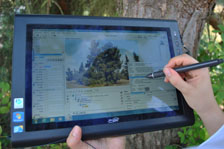IBF Eco
The temporal and spatial distribution of gall inducing sawflies on their host plant species (Salix fragilis) are recorded during two vegetation periods (2009, 2010) on an experimental plot at the Ecological-Botanical Garden of the University of Bayreuth. 40 plants belonging to four previously investigated and described clones are controlled in two week intervals. We record the occurrence of galls induced by Euura testaceipes, Phyllocolpa oblita und Pontania proxima as well as their location on the plant. Allocated shoots and leaves are marked and their growth is estimated by regular measurements. On each plant control shoots, exhibiting no galls are recorded as well. The relevance of shoot length will be investigated in the second year in a manipulation experiment, by pruning back half of the plants from each clone to induce long shoots.
The scientific goal of 2009 to 2011 is to document the spatial distribution and temporal occurrence of the gall inducing species sharing the same host plants and to correlate gall occurrence and densities with factors like shoot length and shoot growth. The technical goal in this period is to test and improve the dataflow, especially to test export interfaces of the Diversity Workbench components to establish multiple possibilities to edit and analyse the previously stored data. Digital data gathering using a smartphone with DiversityMobile as well as the data synchronisation and data transfer to the repository database is tested and optimized during the first year. In the second year of investigation all field data is gained by using DiversityMobile and transferred to the repository database. Furthermore, new possibilities of data transfer back to the scientist, user-friendly data editing and automated data analysis will be developed and tested.
Starting with 2012 there are 3 additional tasks. One is devoted to the test of the DiversityCollection-Application in a local offline installation on TabletPC (Motion J3500) in the field. This is done for ecological studies on an experimental plot at the Ökologisch-Botanischer Garten Bayreuth as well as in an established observation area in the surroundings of Bayreuth. This local installation implies the usage of a new synchronization tool and a separate workflow for multimedia data to the central repository. The integration of the DiversityGisEditor as part of DiversityCollection allows the easy management of geoobjects and the mapping of observations already in the field. Characters of the habitat, e. g. exposition are documented.
The implementation of DiversityMobile on Windows Phone started at the end of 2011. Within IBF Eco the workflow is tested for gathering observation data (incl. host plant, number of individuals, abundance of galls etc.) for plant galls inducing organisms found in a forest near Bayreuth. Furthermore, the applicability of DTN taxon list management, upload functionality for DTN taxon lists, and TK25 topographic maps of Bavaria within the DWB platform will be tested and reviewed in this work package. At the end of the project an inventory of cecidogenous organisms on plants of the selected area is available in the SNSB data repository to be processed to GBIF.
The mobile applications of the IBF project are regularly used by students in practical courses and workshops. Since 2012 a special focus on this topic is set within the course Biosystem Pflanzengallen, held each summer semester by the AG Rambold. For these purposes a separate data pipeline was established.
GBIF Data Resource IBF Monitoring of Galls
Scientists in this workpackage: A. Guhr, Prof. Dr. G. Rambold, Dr. A. Kehl (the latter until 2011)
The DFG funded project IBF expired in 2014.
Ecoinformatics, Department of Mycology, University of Bayreuth
Kehl, A. 2006. Wirtsselektivität gallinduzierender Pflanzenwespen (Hymenoptera, Tenthredinidae) an Weiden (Salix spp.): die Bedeutung von Phänotyp und Genotyp im Salix alba/S. fragilis-Komplex für die Belegung mit Gallen, Dissertation, Universität Bayreuth.
Kehl, A. & Rambold, G. 2008. Genotypical and multiple phenotypical traits discriminate Salix × rubens clearly from its parent species. Plant Systematics and Evolution, 275 (3–4): 169–179.
Kehl, A. & Rambold, G. 2010. Interference of host plant morphology and phenology and their correlation with abundance patterns of the leaf galling sawfly Pontania proxima. Population Ecology (Online First: DOI: 10.1007/s10144-010-0215-8).
Kehl, A., Dötterl, S., Aas, G. & Rambold, G. 2010. Is flower scent influencing host selection in leaf galling sawflies (Hymenoptera, Tenthredinidae) on willows? Chemoecology (Online First: DOI: 10.1007/s00049-010-0050-6).
- Overview table, IBF Datasets accessible by GBIF and other portals



